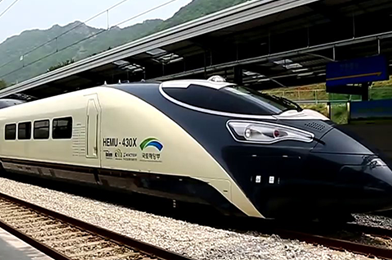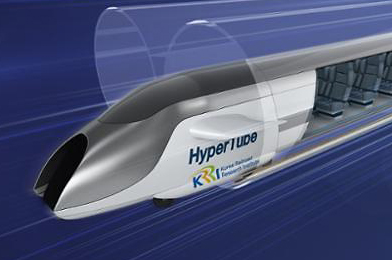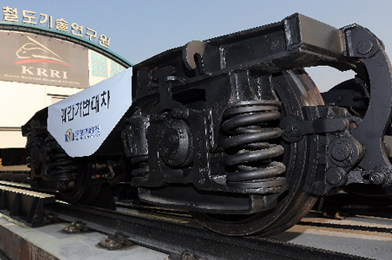RESEARCH PROJECT
-

- Maximum speed : 430 km/h
- Capacity : 456 passengers / train set
- High efficiency induction motor
- Light weight aluminum extruded carbody
-

- 1/1,000 low-pressure, near-vacuum aerodynamics and sealed tube technology
- Electromagnetic levitation technology with freezer separated high temperature superconductor
-

- Y25 (intergrated welding) gauge changing bogie
- Rail gauge : 1,435mm (standard gauge), 1,520mm (broad gauge)
- Maximum speed : 120km/h
- Diameter : 860mm
- Distance between wheels: 1,800mm
KRRI NEWS
-The 21st Korea-China-Japan Railway Technology Exchange Meeting Opens a Platform for East Asian Railway Technology Collaboration -TOKYO, Japan – October 30 – The Korea Railroad Research Institute (KRRI) (President: Sagong Myung) jointly hosted the 21st Korea-China-Japan Railway Technology Exchange Meeting with the China Academy of Railway Sciences Corporation Limited (CARS) and the Railway Technical Research Institute (RTRI) from October 28 to 30 at the Hotel Emisia Tokyo Tachikawa in Tokyo, Japan.A total of 54 participants attended the meeting, including 21 representatives from China—led by CARS Chairman ZHANG Zhifang, 17 participants from Japan—led by RTRI President WATANABE Ikuo, and 16 participants from KRRI, including Vice President Kwon Yong-Jang, to discuss railway technologies across Korea, China, and Japan.KRRI reviewed the progress of 15 joint research projects—including 11 ongoing and 4 newly proposed topics—with CARS and RTRI researchers, and discussed future research plans.On October 28, senior representatives from the three institutions held a trilateral executive meeting, followed by topic-specific discussions and consultations on technical cooperation. On October 29 and 30, the program continued with keynote speeches, presentations on joint research projects, and technical site visits.In the keynote session, Choi Sung-hoon, Executive Director of Rail Vehicle Division of KRRI, presented “20 Years of High-Speed Rail in Korea: Achievements and Future R&D Strategies for Railway Vehicles.” Ma Weibin of CARS delivered a presentation on “Disaster Prevention, Evacuation, and Rescue Systems in Railway Tunnels,” and Arai Hideki of RTRI discussed “Autonomous Train Operation.”Following the keynotes, the three institutions shared and compared research outcomes in various areas, including carbon-neutral strategies and technologies in the railway sector, fire safety and countermeasures in long railway tunnels, and cybersecurity for railway signaling systems. Eleven joint research results were presented, along with four new collaborative topics scheduled for next year.The Korea-China-Japan Railway Technology Exchange Meeting was initiated by KRRI in 2001 and has since developed into an annual international academic event jointly hosted by the three national railway research institutes. Now in its 21st year, the meeting continues to serve as a pkey latform for sharing knowledge and strengthening cooperation among railway researchers in East Asia.President Sagong Myung of KRRI said, “The Korea-China-Japan Railway Technology Exchange Meeting, which is celebrating its 21st anniversary, provided a meaningful opportunity for the leading railway research institutes of East Asia to share current and future directions of railway technology development. KRRI, together with CARS and RTRI, will continue to maintain close collaboration to advance railway technologies and promote joint development across the region”※Attachment: Photos from the 21st Korea-China-Japan Railway Technology Exchange MeetingPress ContactsSunghyun BaekKorea Railroad Research Institutebaeksh@krri.re.kr+82 31 460 5162
UIWANG, South Korea – October 27 – The Korea Railroad Research Institute (KRRI) (President: Sagong Myung) has developed a new concept called the “Smart Railway Logistics Terminal Model” to efficiently expand large-scale urban logistics infrastructure by utilizing railway land.This model integrates rail and road logistics within a unified comprehensive logistics hub by leveraging the vertical space of railway land—such as tracks and adjacent areas—in densely populated regions like the Seoul metropolitan area, while applying advanced smart logistics technologies.Although the need to utilize railway land for urban logistics has been continuously discussed, this model is significant in that it presents a specific and efficient automation-based solution for implementation.Compared to road logistics, traditional railway logistics requires additional truck shuttle operations between departure/arrival points and freight stations, as well as loading and unloading between trucks and freight trains. These extra steps have made railway logistics less competitive in terms of both time and cost.To restore the competitiveness of railway logistics, it is essential to simplify the additional transport processes, such as shuttle operations and cargo handling at railway stations, which currently increase time and cost. This model simplifies the existing transportation process by establishing a “Smart Railway Logistics Terminal”—a comprehensive logistics center built directly above railway tracks where the upper space remains unused.When a freight train delivers containers to the first floor of the terminal, overhead cranes and unmanned guided vehicles (UGVs) immediately transport them to the second floor, which serves as the smart logistics hub.On the second floor, containers are unpacked, and the cargo inside is stored and distributed via trucks. Once emptied, containers are automatically transferred by UGVs to a storage area on the third floor.In addition to the terminal’s architectural design, various smart railway and logistics technologies were incorporated, including an indoor movable overhead contact line, indoor overhead cranes, and large-scale unmanned transport vehicle systems.*The movable overhead contact line enables electric locomotives to safely access the container loading area by shifting the catenary system after entry. This system allows the installation of contact lines even in previously limited areas, eliminating the need to replace electric locomotives with diesel ones for container operations.This research was conducted as part of KRRI’s basic project under the National Research Council of Science & Technology (NST), titled “Development of a Smart Railway Logistics Terminal Strategy to Restore Railway Freight Competitiveness.”With the introduction of multifunctional Smart Railway Logistics Terminal, trains are expected to secure a stronger competitive edge, even within Korea’s short-distance logistics environment.The current research outcomes are scheduled to be presented in greater detail at the 2025 Autumn Conference of the Korean Society for Railway on October 30, 2025, at Maison Glad Jeju.※Related Research ProjectProject Title: Study on the Development of a Smart Railway Logistics Terminal Strategy to Restore Railway Freight Competitiveness(Research Period: January 1, 2025 ~ December 31, 2027)Principal Investigator: Lee In-mook, Director of the Railroad Operations Research Department of KRRIDr. Lee In-mook, Director of the Railway Operations Research Department of KRRI and the project’s principal investigator, stated, “We plan to comprehensively validate the Smart Railway Logistics Terminal model and apply it on a pilot basis to railway land in the Seoul metropolitan area in 2026, with the goal of developing it into a fully practical and commercializable model.”President Sagong Myung of KRRI said, “This achievement represents a citizen-centered research outcome that addresses the growing need for efficient urban logistics infrastructure through the use of railway land. KRRI will continue to contribute to strengthening national logistics competitiveness and increasing the railway’s share of freight transport through the development of advanced railway logistics technologies.”※Attachment: Image of the Smart Railway Logistics Terminal ModelPress ContactsSunghyun BaekKorea Railroad Research Institutebaeksh@krri.re.kr+82 31 460 5162
Korea Railroad
Research Institute

